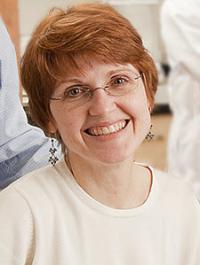

 |
Email: carol_eisenberg@nymc.edu
Address:
Department of Physiology
Basic Sciences Building
New York Medical College
Valhalla, NY 10595
Professional Interests:
Dr. Eisenberg’s research focus is on the signaling mechanisms that underlie how myocardial cell health is maintained in the adult heart. This topic is investigated in her laboratory from three distinct, but overlapping vantage points. The first project examines signaling pathways activated in the diseased heart using the tgG6/lacZ mouse model. The tgG6/lacZ transgenic mouse expresses a β-galactosidase (lacZ) reporter driven by a specific enhancer of the GATA-6 gene, and which serves as a marker for the re-emergence of a fetal gene program in the heart under conditions of stress and disease. The second project involves the development of culture conditions that allow for the long-term maintenance of fully differentiated myocardial tissue in culture, as the means for understanding how the cardiac cells continues to sustain their viability and functional activity. The final project looks at the cell and molecular events guiding the differentiation of stem cells for replacement cardiomyocytes. These three areas of study are complementary to the laboratory’s overall goal of understanding how the functional capabilities of the adult heart can be preserved throughout life.
Education Profile:
Post Graduate Studies: Medical University of South Carolina
Graduate Degree: MS., Ph.D.
Graduate Degree Institution: Villanova University, Cornell University Medical College
Undergraduate Institution: Cabrini College
Selected Bibliography:
Eisenberg, C. A., and D. Bader. 1996. The establishment of the mesodermal cell line QCE6: a model system for cardiac cell differentiation. Circulation Research 78:205-216. PMID: 8575063
Eisenberg, C. A., and R. R. Markwald. 1997. Mixed cultures of avian blastoderm cells and the quail mesoderm cell line QCE6 provide evidence for the pluripotentiality of early mesoderm. Developmental Biology 191: 167-181. PMID: 9398432
Brandon, C., L. M. Eisenberg, and C. A. Eisenberg. 2000. WNT signaling modulates the diversification of hematopoietic cells. Blood 96:4132-4141. PMID: 11110684
Eisenberg, L. M., L. Burns, and C. A. Eisenberg. 2003. Hematopoietic cells from the bone marrow have the potential to differentiate into cardiomyocytes in vitro. The Anatomical Record 274A: 870-882. PMID: 12923898
Eisenberg, L. M. and C. A. Eisenberg. 2004. Adult stem cells and their cardiac potential. The Anatomical Record 276A:103-112. PMID: 14699637
Eisenberg, C. A., J. B. Burch and L. M. Eisenberg. 2006. Bone marrow cells transdifferentiate to cardiomyocytes when introduced into the embryonic heart. Stem Cells 24:1236-1245. PMID: 16410395
Martin, L. K., N. V. Mezentseva, M. Bratoeva, A. F. Ramsdell, C. A. Eisenberg, and L. M. Eisenberg. 2011. Canonical WNT signaling enhances stem cell expression in the developing heart without a corresponding inhibition of cardiogenic differentiation. Stem Cells and Development 20: 1973-1983. PMC3202895
Rémond, M. C., G. Iaffaldano, M. P. O’Quinn, N. V. Mezentseva, V. Garcia, B. S. Harris, R. G. Gourdie, C. A. Eisenberg, and L. M. Eisenberg. 2011. GATA6 reporter gene reveals myocardial phenotypic heterogeneity that is related to variations in gap junction coupling. American Journal of Physiology, Heart Circulation Physiology 301: H1952–H1964. PMID: 21908788
Kaur, K., J. Yang, C. A. Eisenberg, and L. M. Eisenberg. 2014. 5-azacytidine promotes the transdifferentiation of cardiac cells to skeletal myocytes. Cellular Reprograming 16:324-30. PMID:25090621
Kaur, K., J.Yang, J. G. Edwards, C. A. Eisenberg, and L. M. Eisenberg. 2016. The G9a histone methyltransferase inhibitor BIX01294 promotes the expansion of adult cardiac progenitor cells without changing their phenotype or differentiation potential. Cellular Proliferation 49:373-385. doi: 10.1111/cpr.12255. PMID: 27109896
Borghetti, G., C. A. Eisenberg, S. Signore, A. Sorrentino, K. Kaur, A. A. Andrade, J. G. Edwards, M. Nerkar, K. Qanud, D. Sun, P. Goichberg, A. Leri, P. Anversa, L. M. Eisenberg, J. T. Jacobson, T. H. Hintze, and M. Rota. 2018. Notch signaling modulates the electrical behavior of cardiomyocytes. American Journal of Physiology, Heart Circulation Physiology 2017 314:H68-H81. doi: 10.1152/ajpheart.00587.2016. PMID: 28939651
Borghetti, G., C. A. Eisenberg, S. Signore, A. Sorrentino, K. Kaur, A. A. Andrade, J. G. Edwards, M. Nerkar, K. Qanud, D. Sun, P. Goichberg, A. Leri, P. Anversa, L. M. Eisenberg, J. T. Jacobson, T. H. Hintze, and M. Rota. 2018. Notch signaling modulates the electrical behavior of cardiomyocytes. American Journal of Physiology, Heart Circulation Physiology 2017 314:H68-H81. doi: 10.1152/ajpheart.00587.2016. PMID: 28939651
Eisenberg, C. A. and L. M. Eisenberg. 2019. G9a and G9a-like histone methyltransferases and their effect on cell phenotype, embryonic development, and human disease. In “The DNA, RNA, and Histone Methylomes, vol. 9,” p399-433. S. Jurga and J Barciszewski, ed., Springer Nature, Switzerland, pub.
Mitry, M. A., D. Laurent, B. L. Keith, E. Sira, C. A. Eisenberg, L. M. Eisenberg, S. Joshi, S. Gupte, J. G. Edwards. 2020. Accelerated cardiomyocyte senescence contributes to late-onset doxorubicin-induced cardiotoxicity. American Journal of Physiology, Cell Physiology 318: C380-91. https://doi.org/10.1152/ajpcell.00073.2019. PMID: 31913702
Search PubMed for all available publications of Carol A. Eisenberg, Ph.D.